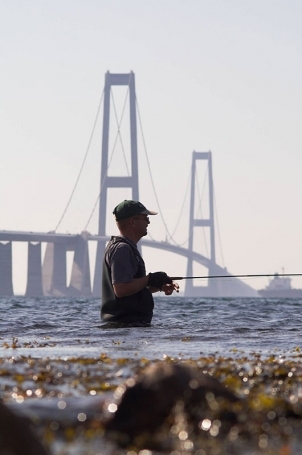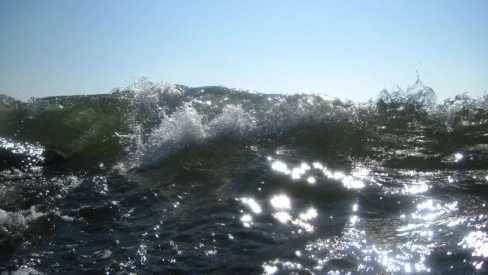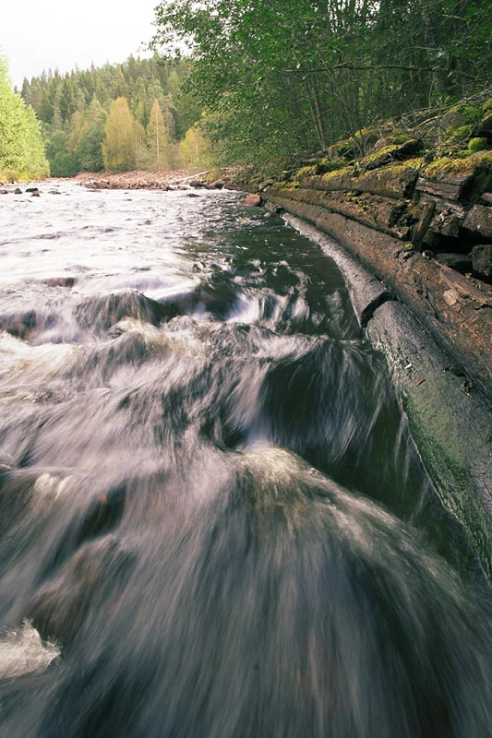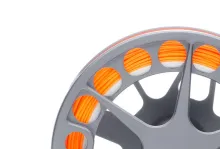Shooting pictures close to the surface can give an exciting perspective that will enhance the feeling of being near the water... literally! This is yet another chapter in our long series about taking better fishing pictures.
The go low rule also applies when you are shooting in the water - wading or sailing. Going close to the surface can give an exciting perspective that will enhance the feeling of being near the water... literally!
You can get
a perspective, which offers a better view of the angler by moving the camera away from eye or shoulder level and down towards the water. One thing is the exciting and different angles you can obtain, but in other cases your subject might be close to the surface: fly rod and reel and angler's hands while stripping in line or a fish being landed, held up for presentation or released.
In such situations the subject is low down, and a camera angle from above and down won't give nearly as good pictures as a camera held low.
When shooting landscapes
or waterscapes over water or from a position standing in the water, you might also consider using a very low angle. Getting waves, rocks or emerging water plants into the frame can offer great foregrounds, which enhances the perspective of most images. Finding foreground subjects in such pictures can be hard, but since the water is always there, it's worth considering using that as an element in the picture.
Lowering your camera
towards the water can be a harrowing experience, not least when fishing in rough streams, wind swept lakes or in the ocean, where the surface is everything but calm. Unless your camera is waterproof, you will have to be very careful to keep the camera out of the wet element and avoid splashes. On other types of water like calm lakes and smooth streams, you might not have to be quite as careful.
You can do
different things to ease the photography and lower the risks of dipping the camera. Focus and adjust the camera before lowering it. On some cameras this can be done independently of pressing the exposure button, and you can use that method. On cameras where these settings are coupled to the exposure button, you can half-press the button while having the camera safely above the water, keep it pressed while lowering the camera and pressing the button fully to expose once the camera is in position.
Composing the picture
can of course be a challenge, because you can't look in the viewfinder or see the LCD-screen on the back of the camera. Some cameras have a flip-out screen, which allows you to see it from above and compose while the camera is lowered, but most cameras don't have this option.
In that case
you will have to guesstimate the composition. Using a wideangle setting on the lens can make it easier to get everything in the frame, and the wide angle also gives a greater perspective in the final image.
A small tip
is to hold the camera with your thumbs on top, and the rest of the fingers underneath. This is a much more convenient hand position and makes it easier to keep the camera level. At the same time you have your fingers under the camera, and can feel the water if you get too close. Extend a finger and you have a nice distance measure, which will alarm you if you get too close to the water, and you can use a thumb to press the exposure button.
Martin Joergensen
If you have
a free view to the horizon, the opposite bank or some other background, you want this to be seen in the picture. Make sure that you tip the camera a bit upwards when shooting from the low position. You want background and sky in the top of the picture rather than uniform water surface in the lower part.
Using a waterproof camera makes it a lot less risky, and also offers the option of half dipping the camera and getting really low and maybe even partially under the water. This can give some stunning images where you see both the fish below and the angler above the water in one and the same picture.
- Log in to post comments





























That's what makes th
That's what makes the different : a story and some pictures
an interesting story with pics
the mother of all articles including well shoot material!
Martin I propose: go ahead with such nice how to do chapters !
best Heiko